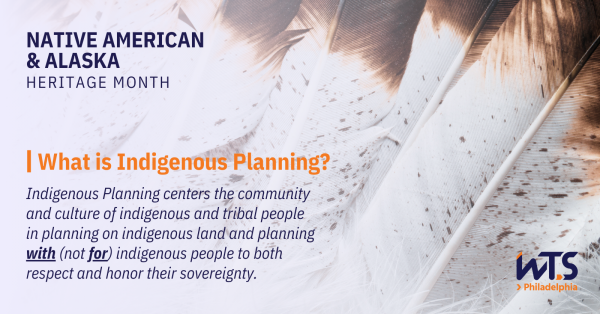A Brief Introduction into Indigenous Planning for Native American and Alaska Heritage Month

By: Mia Held, MCRP, Aviation Planner, C&S Companies
We gratefully acknowledge that the land where we live and work in the Philadelphia Region sits on the ancestral lands of the Lenape People. This Native American and Alaska Heritage Month, wherever you live and work, we encourage you to learn more about the original people of that land and to understand their history and to honor the role of their ancestors and descendants in your community.
In honor of November’s Native American and Alaska Heritage Month, WTS Philadelphia is highlighting an important discipline in the Engineering, Design, Architecture, and Planning fields, Indigenous Planning.
Indigenous Planning centers the community and culture of indigenous and tribal people in planning on indigenous land and planning with (not for) indigenous people with the goal of honoring their sovereignty and personhood. There is a long and shameful history of policymakers, planners, architects, engineers and many other professionals planning “for” indigenous communities, deciding that they/we know what is best for these communities and not allowing indigenous people to lead their own planning process. The role of a planner today is to provide a platform in any design process- from the planning process through design, construction, and implementation- to allow indigenous communities to chart their own path.
Some key questions to consider in the pursuit of a base-level understanding of indigenous planning include:
- How can I center indigenous community members in the very first steps of the planning process?
- How can I listen more than I speak?
- How can communications be delivered through methods that work for that community? This will likely mean re-thinking traditional outreach methods to develop a tailored approach to outreach, engagement, marketing, etc. Just an online survey won’t cut it!
- How can we widen our understanding of “knowledge” and “data” to include stories, verbal histories, quantitative and qualitative data and beyond to raise up indigenous felt knowledge? (“Felt Knowledge” is an indigenous knowledge, rooted in tradition, that includes an awareness of everything a person feels and knows about a given subject)
Are you honoring Indigenous Knowledge? A key element in understanding the fundamentals of Indigenous Planning is understanding and centering Indigenous Knowledge, or the ceremonies, cultural practices, and wisdom of the generations as a primary source of information in collaborating with indigenous communities. In December 2022, the White House released guidance on the significance of Indigenous Knowledge and pathways to center this knowledge into federal, state, and local planning practices.
Where Can I Study Indigenous Planning and Policy? Several Universities and Colleges in the United States have Indigenous Planning programs, educating current and future generations of planners and policymakers on key issues to tribal communities. Some programs include those at The University of New Mexico, The University of Arizona, and the Massachusetts Institute of Technology.
Want to learn more about your role? Visit the website of the American Planning Association to learn about how planners are working toward a vision of championing indigenous planning issues.
_____________________________________________________________________________________
From the author: While I am a proud graduate of the Masters of Community & Regional Planning at the University of New Mexico, home to one of the only Indigenous Planning Programs in the nation, I humbly present the information within this article on the practice of Indigenous Planning as a non-indigenous person. To learn more about the topic from the best possible source, please refer to the Indigenous planners, scholars, historians, and philosophers who have authored the books below or, to the programs referenced in this article. We as design professionals have so much to learn from Indigenous Communities, and I am proud to highlight this important discipline to further the understanding and integration of Indigenous Planning into our profession:
How It Is: The Native American Philosophy of V.F. Cordova, How It Is | UAPress (arizona.edu)
Spiral to the Stars: Mvskoke Tools of Futurity by Dr. Laura Harjo Spiral to the Stars | UAPress (arizona.edu)
The Original People: The Ancient Culture and Wisdom of the Lenni-Lenape People by Chief Quiet Thunder and Gregory Frank Vizzi, THE ORIGINAL PEOPLE: THE ANCIENT CULTURE AND WISDOM OF THE LENNI-LENAPE PEOPLE BY CHIEF QUIET THUNDER AND GREG VIZZI by MR GREGORY FRANK VIZZI | Goodreads
As Long As the Grass Grows: The Indigenous Fight for Environmental Justice, From Colonization to Standing Rock, by Dina Gilio-Whitaker, goodreads.com/book/show/41183866-as-long-as-grass-grows